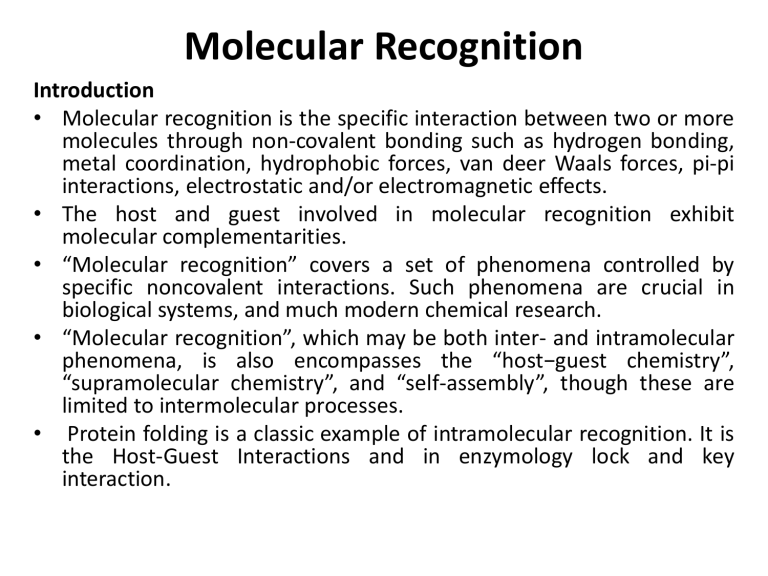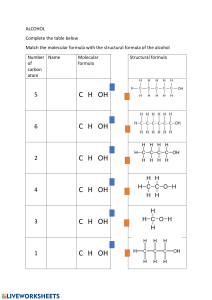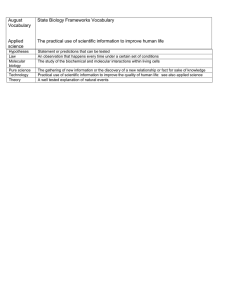
Molecular Recognition Introduction • Molecular recognition is the specific interaction between two or more molecules through non-covalent bonding such as hydrogen bonding, metal coordination, hydrophobic forces, van deer Waals forces, pi-pi interactions, electrostatic and/or electromagnetic effects. • The host and guest involved in molecular recognition exhibit molecular complementarities. • “Molecular recognition” covers a set of phenomena controlled by specific noncovalent interactions. Such phenomena are crucial in biological systems, and much modern chemical research. • “Molecular recognition”, which may be both inter- and intramolecular phenomena, is also encompasses the “host−guest chemistry”, “supramolecular chemistry”, and “self-assembly”, though these are limited to intermolecular processes. • Protein folding is a classic example of intramolecular recognition. It is the Host-Guest Interactions and in enzymology lock and key interaction. Schematic presentation of “Lock and key” interaction in enzymology and the “host−guest chemistry”. Types of Molecular Recognition: Molecular recognition can be subdivided into-= 1. static molecular recognition 2. Dynamic molecular recognition. Static molecular recognition • It is interaction between a key and a keyhole; it is a 1:1 type complexation reaction between a host molecule and a guest molecule to form a host-guest complex. • To achieve advanced static molecular recognition, it is necessary to make recognition sites that are specific for guest molecules. Dynamic Recognitions: In dynamic recognition binding the first guest at the first binding site induces a conformation change that affects the association constant of the second guest at the second binding site, a positive allosteric site. In the case of dynamic molecular recognition the binding of the first guest to the first binding site of a host affects the association constant of a second guest with a second binding site. In the case of positive allosteric systems the binding of the first guest increases the association constant of the second guest While for negative allosteric systems the binding of the first guest decreases the association constant with the second. The dynamic nature of this type of molecular recognition is particularly important since it provides a mechanism to regulate binding in biological systems. Dynamic molecular recognition is also being studied for application in highly functional chemical sensors and molecular devices. Molecular Recognition in Supramolecular Systems • Chemists have demonstrated that artificial supramolecular systems can be designed that exhibit molecular recognition. One of the earliest examples of such a system is crown ethers which are capable of selectively binding specific cations. However, a number of artificial systems have since been established. Pedersen’s synthesis of crown ether and the discovery of Molecular recognition. Applications of Molecular Recognition • Molecular recognition acts as- Sensor, Molecualr motor, Enzyme mimetic catalysis, Self organization • Binding of the guest leads to measurable change in the physical properties of the host. • Molecular recognition is used to differentiate between enantiomers • E.g. crown ether developed by Cram was able to resolve the recemic ammonium salt and amino acids. • Molecular recognitions in biological system– A non-covalent interaction bet. Different sets of macromolecules leads to supramolecular assemblies that serve specific subcellular functions in biology – E.g. ribosomes are supramolecular assemblies of proteins & RNA., proteins, nucleic acids, lipids, – Cell organells-nucleus, mitochondria, endoplasmic reticulum – Protein embedded in the lipid bilayer membrane • An important example of molecular recognition is the antibiotic vancomycin that selectively binds with the peptides with terminal D-alanyl-D-alanine in bacterial cells through five hydrogen bonds. The vancomycin is lethal to the bacteria since once it has bound to these particular peptides they are unable to be used to construct the bacteria’s cell wall. Protein-Ligand Complexation-A Molecular Recognition Changing structure of ligand leads to changes in biding affinity. Ligand pre-recognization , hydrophobicity, hydrogen boding capability affects energies in proteinligand interaction. Protein-Ligand Complexation-A Molecular Recognition Protein-Small Molecule Interaction-A Molecular Recognition Protein-DNA Interaction-A Molecular Recognition Protein-Protein Interaction-A Molecular Recognition • http://nptel.ac.in/courses/104103018/4 • http://nptel.ac.in/courses/104103018/5




